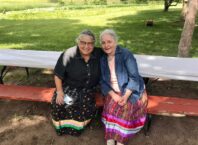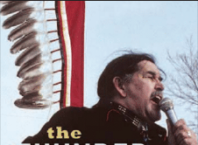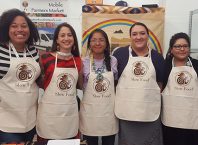Getting Out The Native Vote
Native Vote Launches National Grass-roots Media Campaign
The National Congress of American Indians launched a national grassroots media campaign in September alongside leading national Native media organizations to encourage Native people to register to vote and participate in the 2012 national election.
The new campaign titled "Every Native Vote Counts" is part of the organization’s ongoing non-partisan voter outreach effort, Native Vote. Native Vote works with community organizers, non-profits, urban Indian centers, tribal governments, and regional organizations to create a strong and permanent infrastructure for election training that highlights voter registration, election protection policies, and voter education.
With a goal of turning out the largest Native vote in history in 2012 NCAI reached out to members of the media to participate in the campaign and hopes these critical partners are joined by many more in the coming weeks.
"Turning out the largest Native vote in history requires all of Indian Country working together and the Native media will play a critical role in reaching our goal. These Native media partners are volunteering the air waves – radio and television, the print media, and the web to send Indian Country an important message, ‘Every Native Vote Counts’," said Jefferson Keel, President of NCAI, the nation’s oldest and largest American Indian and Alaska Native advocacy organization. "We are excited that so many Native media outlets have stepped forward to support this national effort. This message should be part of every community gathering between now and November 6, 2012."
Native Vote has produced over a dozen Public Service Announcements (PSAs) available in video and audio for download, broadcast, and online sharing available at NativeVote.org. Additionally there are a range of materials that can be printed and distributed in communities. The PSA videos and radio spots feature messages from tribal citizens, mothers and fathers, veterans, elders, tribal leaders, celebrities, and athletes.
The national grassroots media campaign is also helping to register Native voters online. Participating websites will provide voters with the ability to register using Native Vote’s partner tools. Through a new partnership with Turbo Vote, Native Vote is making it easy for voters to register to vote online at: http://nativevote.turbovote.org. Turbo Vote delivers voter registration materials to an individual’s home with a pre-stamped envelope.
Tribal newspapers, radio stations, television stations, online destinations, and other media outlets are encouraged to join the effort by disseminating the campaign’s PSAs and encouraging voter registration via social media, television, radio, and print publications.
Native Vote Action Week Held
Native Americans turned out in force to join together in one of the largest weeks of voter engagement, education, and non-partisan actions since securing their rightful place at the ballot box in the Voting Rights Act of 1965.
Native Vote Action Week was organized by the NCAI and brought together Indian Country in an effort to raise awareness about the importance of civic engagement and increase Native voter participation. Over 130 registration drives, rallies, and events were hosted by tribal communities, Native Vote organizers, and organizations serving Indian Country and Native youth during the week of Sept 24.
"Now is a crucial time for Indian Country to work together to get Native Voters registered and ready to go to make our voice heard on November 6th as we participate in national and state elections,"said NCAI President Jefferson Keel.
Native Vote Action Week is a response to Keel’s call during the January 2012 State of Indian Nations, for the largest Native voter turnout in history. "The Native vote counts for our people, our rights, and our culture. We must raise our voice and remember, that every Native vote counts."
Two out of every five eligible American Indian and Alaska Native voters are not registered to vote and in 2008 over 1 million eligible Native voters were unregistered.
September 25, 2012 marked National Voter Registration Day during which hundreds of national partners, including Native Vote, registered and educated voters.
Voter Suppression Threatens Elections
In 2011, a troubling trend took hold around the country as more than 40 conservative state legislatures began introducing changes to their voting procedures. While these new laws vary from state to state, they all have the effect of making it harder to vote, especially for African Americans, Latinos and low-income citizens.
Voting laws in many states have changed. Many Americans will travel to the polls on Election Day only to find out their vote won’t count.
n Voter ID
At least 34 states introduced, and 11 states passed, laws requiring voters to present state-issued photo ID at the polls before casting a ballot. These restrictive laws generally ban the use of common types of identification like utility bills, bank statements, or student IDs, allowing only limited forms such as a driver’s license or passport.
To obtain state-issued photo ID, most states require up to four underlying forms of identification, including a certified birth certificate or social security card, which many citizens must either track down or purchase for up to $25. All names on the underlying documents must match – an added obstacle for people who have changed their names or whose records contain errors. For those born at home, a birth certificate may not exist at all.
n Proof of citizenship laws
At least 17 states introduced, and three states have enacted, laws that require documentary proof of citizenship to register to vote. Such requirements were previously unheard of because federal law already provides protections against noncitizens registering to vote – including penalties of up to five years in prison, $10,000 in fines, and deportation. Yet these state laws mandate that Americans seeking to register must provide a birth certificate, unexpired passport or naturalization papers.
In addition the fact that many citizens lack such documents, which can be costly and difficult to obtain, proof-of-citizenship laws severely hinder voter registration drives. Because they are usually set up in public places where communities congregate (and most people don’t walk around with their birth certificates or naturalization records), these laws make registration drives far less effective.
n early voting Reductions
At least nine states introduced, and five states passed, laws that reduce early-voting periods. African-American and Latino citizens are twice as likely to use early voting than whites.
The reductions include slashing the number of days for early voting, as well as eliminating early voting during weekends and evening hours, making ballot access harder for low-income working people who can’t get off work. In Florida, the state legislature expressly took out the Sunday before Election Day, when many black churches held successful "Take Your Souls to the Polls" campaigns encouraging their congregants to vote.s
n harder registrations
Texas and Florida passed laws that place onerous requirements and penalties on non-profit and community groups – such as the League of Women Voters, NAACP, or churches – that conduct voter registration drives. In Florida, among other requirements, these groups must submit all completed registration forms to election officials within 48 hours or face fines of up to $1,000 per application.
Unable to risk such a financial burden, many voter registration groups have shut down operations under these restrictions. African-American and Latino voters register through third-party drives at nearly twice the rate of white voters.
n registered voter purges
Fourteen states are pursuing efforts to summarily purge registered voters from their voter rolls based on flawed suspicion of their citizenship status. Florida took the lead in 2012, targeting thousands of voters to be purged from the rolls. Eighty-seven percent of voters on the list were people of color, and more than 60% were Latino. The list was also found to have a 78% error rate, with thousands of registered citizens erroneously targeted for purges.
Now Florida and 13 other states are trying to purge their rolls using federal immigration data, which the Department of Homeland Security acknowledges is incomplete and flawed.
n Disenfranchising felony convicts
Eleven states ban people from voting after they have completed their sentences. In 2011, Florida and Iowa joined Virginia and Kentucky, as the only states to enact the extreme measure of permanent disenfranchising individuals with past felony convictions, banning them from the ballot box for life.
"Voter Suppression Threatens Elections" was reprinted with permission of the Advancement Project. For more info, see: http://www.advancementproject.org.
MINNESOTA VOTER INFORMATION
o Election Date: November 6
o Voter Registration Deadline: October 17 (20 days before the election).
o Election Day Registration: Yes
o ID Required to Vote: No ID required if you registered before arriving at the polling precinct.
Voter Registration Eligibility:
o At least 18 years old on Election Day
o A citizen of the United States
o A resident of Minnesota for 20 days immediately preceding Election Day
o Not under court-ordered guardianship in which the court order revokes your right to vote or not been found by a court to be legally incompetent to vote
o Not convicted of a felony, your felony sentence has expired (been completed,) or you have been discharged from your sentence
ID Required to Register: To register to vote you need to provide your Minnesota driver’s license number or Minnesota ID number or the last 4 digits of your social security number. To register at the polling place on Election Day, you must have authorized proof of residence.
Absentee Ballot Deadline: Completed absentee ballots must be received by the day before Election Day.
Early Voting: In person absentee voting is allowed but an excuse is required.
Info taken from the Minnesota Elections Website






